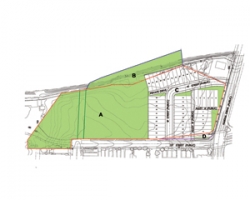Seal Beach city officials and Bay City Partners, owners of the property that is the former site of the Los Angeles Department of Water and Power plant, are at odds again over plans for its development.
The property is located at First Street and Marina Drive and along the San Gabriel River jetty in Old Town Seal Beach.
At issue is the actual size of the project area and the split between the portion to be developed and how much open space will be left over.
At this time, the city says Bay City Partner’s current plan delivers only 60 percent open space, while the required specific plan calls for 70 percent of the property to be left undeveloped.
Ed Selich, Bay City’s project manager, disagrees with the city’s accounting of the open space. He said the city’s calculations are based on an out of date specific plan because the property owners have submitted an amended specific plan.
Selich said the city actually gets more than 70 percent open space.
“The bottom line is that when the city adopted the specific plan, the city expected to get 6.62 acres of open space,” Selich said. “Bay City Partners is providing 6.749 acres.”
Mark Persico, Seal Beach’s director of Development Services does not see it that way.
“I can’t say I entirely follow their argument, but I think the crux is that within the original specific plan from 1982 and the revised one adopted in 1996, there are inconsistencies. When we look at the legal descriptions there are different boundaries. However, at the end of the day, the total site is 10.7 acres. If and when the project is approved we (the city) will be buying 6.4 acres. If you take the raw numbers there is no way to get to 70/30 percent open space versus development.”
Persico said the city based its calculations on the 1996 specific plan.
“Our project description notice we prepared is correct and we believe our numbers are correct,” Persico said. “If you do the simple math and divide 10.7 by 4.2 you come up with 40 percent of the property being developed.”
Selich said the city is ignoring the fact that Bay City Partners are asking for an amendment to the 1996 specific plan and a change from visitor/resort use to allowing for residential development.
The specific plan the city adopted in 1982 called for a 300-room hotel. The 1996 plan lowered the number of hotel rooms to 150. Bay City Partners is asking for a specific plan that would allow 48 residential homes.
Persico disagrees with Selich’s conclusion.
“They are talking about part of their tract that is not part of the project area,” Persico said. “There are different ways to look at open space. If you look at the greenbelt (in Old Town Seal Beach along Electric Avenue) that is space people could use. That is open parkland. But if you look at Herron Pointe where there are spaces between houses, you can’t call that ‘open space.’ You can’t go in there and have a picnic with your family.”
Persico said it was up to the city to decide what is actual open space and what is not.
“We can argue all day over the questions 70 percent of what? Or when is 60 percent really 71.3 percent,” Selich said. “However, at the end of the day the city is getting 0.129 more acres of open space than they expected.”
The current conundrum is the latest in what has been a contested bid by Bay City Partners to develop the property it bought in May of 2003 for $4.5 million. The property owners and the city recently settled a lawsuit in the property owner’s favor when the city attempted to take some of Bay City’s property through the process of eminent domain.
The court ordered the city to give Bay City’s proposed plan a fair hearing.
That process is still just beginning.
“The process just started to complete an environmental impact report,” Persico said. “The results are due in December. We will start the public hearings before the planning commission and the City Council in early 2012.”
Persico said the process will also include reports from various City Council appointed committees such as the city Environmental Quality Control Board and the DWP Advisory Committee, whose members, Persico said, are supposed to remain neutral about the plan.
On another issue, some opponents of the plan have suggested that the property was contaminated by asbestos fallout when the defunct power plant was demolished. According to city records from 1987, which were approved by the County of Orange Health Care Agency, the property’s clean up was approved.
In a memo at the time from Ed Knight, the city’s director of Development Services to City Manager Bob Nelson he said: “As the letter from the County indicates, no further action is needed on the DWP site, and the cleanup has been completed.”




